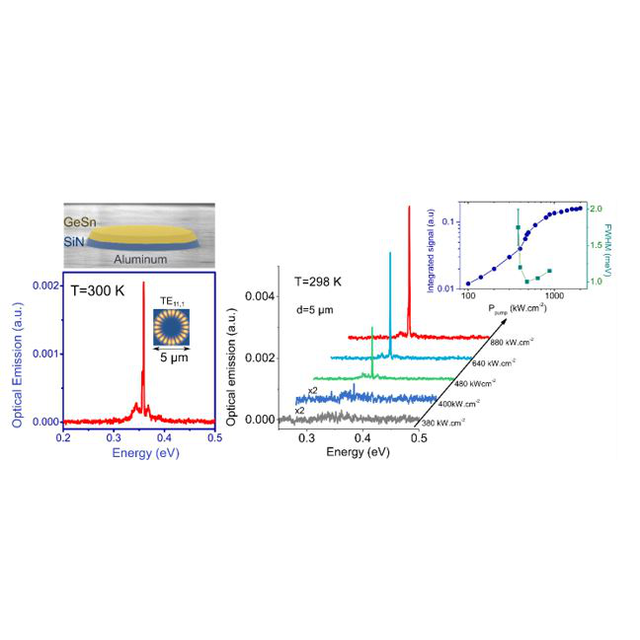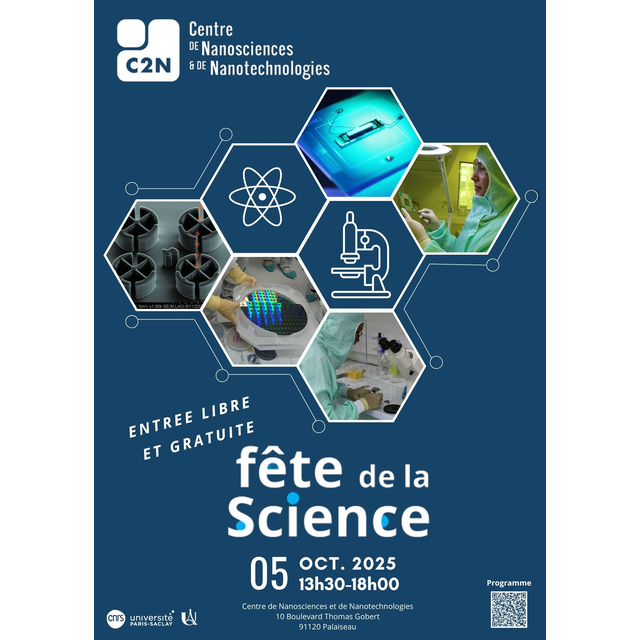A C2N team, in collaboration with CEA Grenoble (LETI and IRIG) and STMicroelectronics, presents the first room temperature laser with GeSn, a group IV semiconductor compatible with silicon fabrication. This major result is published in Optics Express.
GeSn alloys are the most promising direct band gap semiconductors to demonstrate full CMOS-compatible laser integration with a manufacturing from Group-IV materials. An important milestone towards real-field applications is the ability to operate at room temperature (RT). So far, the highest temperatures achieved for laser operation with GeSn were 273 K at prohibitive power threshold densities of several MW/cm2. Here, we show for the first time that room temperature and above, up to 300 K, lasing can be obtained with GeSn. In addition the threshold densities are reduced to few hundreds of kW/cm2. This is achieved in microdisk resonators fabricated on a GeSn-On-Insulator platform that combine strain engineering with a thick layer of high Sn content GeSn. As previously detailed in recent publication [1] the main assets of this specific laser technologies are, first, to enable the removal of interfacial defect, second, to improve the optical confinement in the gain region as compared to conventional approach based on as grown GeSn /Ge buffer stacks on silicon. Third, the strain transfer from the insulator yields a higher directness of the band structure of the alloy and more robust gain then. Finally the whole structure is fabricated on an aluminum heat sink for improved thermal cooling of the gain media.
This achievement published in Optics Express[2] open the route to real field application of CMOS-compatible Mid-infrared lasers. This work has been developed in a collaboration between C2N-University-Paris-Saclay-CNRS and CEA in Grenoble (LETI and IRIG) with STMicroelectronics.
[1] B. Wang et. al. GeSnOI mid-infrared laser technology. Light Sci Appl 10, 232 (2021). https://doi.org/10.1038/s41377-021-00675-7
[2] A. Bjelajac et. al. Up to 300 K lasing with GeSn-On-Insulator microdisk resonators. Opt. Express 30,
Up to 300 K lasing with GeSn-On-Insulator microdisk resonators
A. Bjelajac1, M. Gromovyi1, E. Sakat1, B. Wang1, G. Patriarche1, N. Pauc2, V. Calvo2, P. Boucaud3, F. Boeuf4, A. Chelnokov5, V. Reboud5, M. Frauenrath5, J.-M. Hartmann5, and M. El Kurdi1
Optics Express Vol. 30, Issue 3, pp. 3954-3961 (2022)
doi.org/10.1364/OE.449895
1Université Paris-Saclay, CNRS, C2N, 10 boulevard Thomas Gobert, 91120 Palaiseau, France
2Université Grenoble Alpes, CEA, IRIG-DePhy, 17 rue des Martyrs, 38000 Grenoble, France
3Université Côte d’Azur, CNRS, CRHEA, Rue Bernard Grégory, 06905 Sophia-Antipolis, France
4STMicroelectronics, Rue Jean Monnet, 38054 Crolles, France
5Université Grenoble Alpes, CEA, Leti, 17 rue des Martyrs, 38000 Grenoble, France
Figure : On the left hand is shown the SEM image of a GeSn microresonator based on GeSnOI platform recently developed at C2N. The emission from such cavities, here with 5 µm diameter shows laser effect up to 300 K with threshold of 500 kW/cm2 under puled optical pumping. The right figure show detailed analysis of laser characteristics at 298 K.









